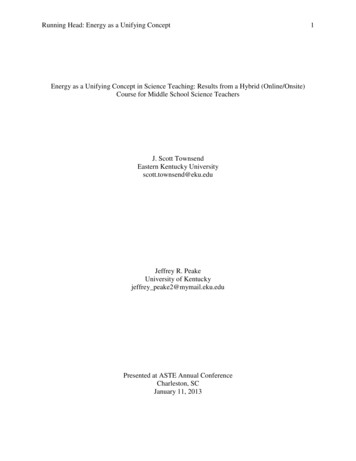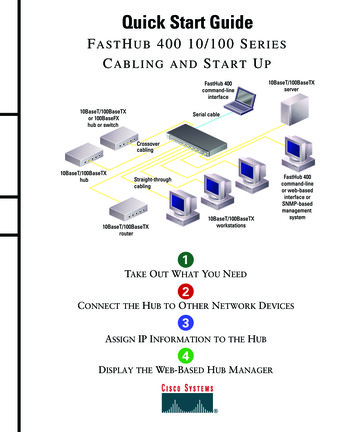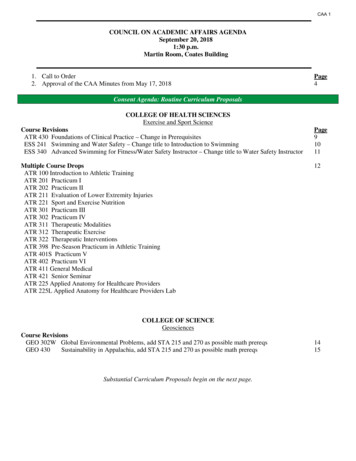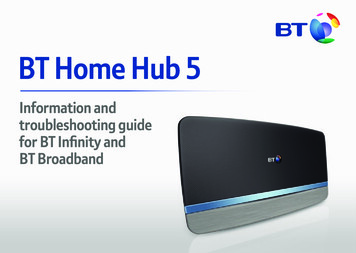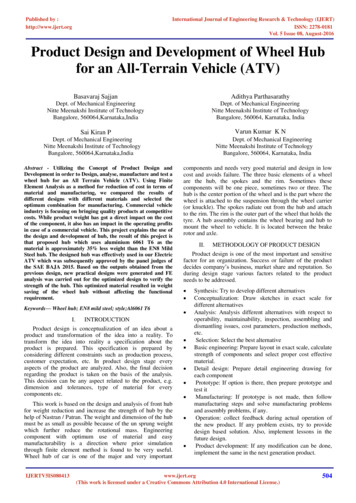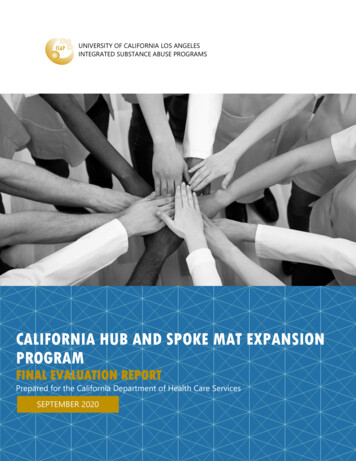
Transcription
UNIVERSITY OF CALIFORNIA LOS ANGELESINTEGRATED SUBSTANCE ABUSE PROGRAMSCALIFORNIA HUB AND SPOKE MAT EXPANSIONPROGRAMFINAL EVALUATION REPORTPrepared for the California Department of Health Care ServicesSEPTEMBER 20200
About This ReportThis report was prepared by the UCLA Integrated Substance Abuse Programs (ISAP) forthe California Department of Health Care Services (DHCS) in September 2020. All datareported cover the first three years of implementation efforts of the Hub and Spokeprogram, a component of the California State Targeted Response (STR) to the OpioidCrisis.AuthorsKendall Darfler, MSAida Santos, BSLiliana Gregorio, BSEva Vazquez, BSBrittany Bass, PhDVandana Joshi, PhDValerie Antonini, MPHElizabeth Hall, PhDCheryl Teruya, PhDJosé Sandoval, BSDarren Urada, PhDPrincipal InvestigatorDarren Urada, PhDAcknowledgementsThe authors thank Richard Rawson and Mark McGovern for their ongoing consultationon the evaluation of the Hub and Spoke model. Both Drs. Rawson and McGovern wereinvolved in the Vermont Hub and Spoke project, and their input has been instrumentalto the current project. We also thank the UCLA implementation team, including GloriaMiele, Thomas Freese, Beth Rutkowski, Kimberly Valencia and Christian Frable for theirinvaluable feedback. Thanks also to Robert Small, Becky Hoss, Frances Southwick, IraFreeman and Nancy Lee for their input on pharmacy issues.The authors would also like to acknowledge that the Hub and Spoke program and itsevaluation have been carried out on the traditional lands of more than 154 indigenousnations.Recommended citation: Darfler, K., Santos, A., Gregorio, L., Vazquez, E., Bass, B., Joshi, V., Antonini, V.,Hall, E., Teruya, C., Sandoval, J., Urada, D. (2020). California State Targeted Response to the Opioid Crisis:Final Evaluation Report. Los Angeles, CA: UCLA Integrated Substance Abuse Programs1
ContentsList of AcronymsGoals of the Hub and Spoke ProgramExecutive SummaryIntroductionOpioid Use Disorders and the California Treatment LandscapeCalifornia Hub and Spoke ProgramEvaluation Report FrameworkMethodsLimitationsHub and Spoke ImplementationData in Focus: Provider StigmaPatient Numbers and Preliminary OutcomesHub PatientsSpoke PatientsTreatment OutcomesData in Focus: Fentanyl UseData in Focus: StimulantsAvailability and AccommodationPromising PracticesApproachabilityPromising PracticesAcceptabilityUnhoused PatientsPatients Speaking Languages Other Than EnglishPeople of ColorPatients Living in Rural AreasPatients with Co-occurring Mental Health DiagnosesPromising PracticesAffordabilityPromising PracticesAppropriatenessPromising PracticesRecommendations and Next StepsSummary of Promising 14245495455646570727678798082838487889798991012
List of AcronymsCDPHCHCFCSAMDATA QUCLAUSCXR-NTXCalifornia Department of Public HealthCalifornia Health Care FoundationCalifornia Society of Addiction MedicineDrug Addiction Treatment Act of 2000Department of Health Care ServicesFederally Qualified Health CenterHub and Spoke SystemIntegrated Substance Abuse ProgramsMedications for Addiction Treatment1Office Based Opioid TreatmentOBOT Stability IndexOpioid Treatment ProgramOpioid Use DisorderSubstance Abuse and Mental Health AdministrationState Opioid ResponseState Targeted ResponseTreatment Needs QuestionnaireUniversity of California Los AngelesUniversity of Southern CaliforniaExtended-release naltrexoneMAT has also historically referred to Medication Assisted Treatment, which suggests the medication is secondary to othertreatment. Wakeman (2017) argues this contributes to stigma and treats MAT differently from medications for other conditions. Wetherefore use the more neutral term Medications for Addiction Treatment in this report.13
Goals of the Hub and Spoke ProgramThe goals of the California Hub and Spoke program, as outlined in the Strategic Plan, include:Implement Hub and Spoke modelthroughout CaliforniaDevelop prevention and recoveryactivitiesThe primary aim of the MAT Expansion Projectis to implement the Hub and Spoke model toincrease access to opioid use disorder (OUD)treatment. This includes developing OTPs asregional subject matter experts and referralresources. Treatment expansion efforts focuson medications, but also include counselingand other supportive recovery resourcesthrough case management.Prevention and recovery activities to supportMAT expansion include providing naloxone,coordinating with local opioid coalitions,reducing stigma among the public as well asproviders, developing physician MATchampions, promoting use of the CaliforniaSubstance Use Warmline, and providingeducation and technical assistance to all typesof treatment providers (e.g., counselors, peersupport workers, nurses) throughout the state.Increase availability of medications foraddiction treatment (MAT)MAT expansion efforts focus primarily onbuprenorphine as these medications can beprescribed by any provider with a DrugAddiction Treatment Act of 2000 (DATA 2000)waiver. Waivered providers working in primarycare settings, such as Federally QualifiedHealth Centers (FQHCs), are an importanttarget of expansion efforts. Increasing theavailability of buprenorphine in medicallyunderserved areas, particularly among personscovered by Medi-Cal is an important sub-goalof the program.Increase number of waivered providerswho can prescribe MATIn order to enhance the statewideinfrastructure for MAT availability, it is criticalto increase both the number of providerswaivered to prescribe buprenorphine as wellas the number of patients per provider. At thetime the Strategic Plan was written, Californiawaivered providers managed an average offive OUD patients at a time. Increasing thenumber of prescribers applies to all types ofallowable providers.Establish Learning Collaboratives andprovide trainingsLearning Collaboratives are a key componentof the Hub and Spoke model. They serve as aforum for didactic education about addictionmedication and other evidence basedpractices, allow for regional relationshipbuilding among providers and administrators,and offer opportunities to discuss barriers andfacilitators to program implementation.Improve medication access for tribalcommunitiesIn 2017, the opioid overdose death rate forAmerican Indian/Alaska Natives (AI/AN) was17.8 per 100,000 persons, over three times thestate average of 5.2 per 100,000 (CDPH 2018).Assessing both the OUD treatment andprevention needs as well as existing resourcesin tribal and urban indigenous communities isessential to developing culturally relevanttreatment expansion efforts. A team of expertsfrom a number of AI/AN organizations, led byClaradina Soto, PhD, at the University ofSouthern California (USC) conducted a needsassessment of MAT and other culturallyrelevant treatments, including traditional4
healing practices, for OUD in indigenouscommunities in California. UCLA works closelywith this team, but the two groups havedetermined that it is most appropriate for theresearch to be designed and carried out bythose with the expertise and culturalknowledge needed to best serve thecommunities. A separate report was submittedto the Department of Health Care Services byUSC detailing the outcomes of the needsassessment and recommended futuredirections for treatment expansion efforts.Conduct a program evaluationUCLA is conducting the evaluation of the Huband Spoke MAT Expansion program. Theevaluation includes regular reports onSAMHSA-required performance measures,creation of a data reporting structure for allHub and Spoke Systems, surveys of providers,patient interviews, and qualitative site visits toa selection of programs. This report includesthe outcomes of the second year of evaluationefforts.5
Executive SummaryThe California Hub and Spoke (H&S) program rapidly responded to the state’s growing opioidoverdose crisis. The goal of the program was to increase access to medications for addictiontreatment (MAT) throughout the state, with a particular emphasis on buprenorphine, which canbe prescribed in low-barrier, office-based treatment settings. This evaluation report iscumulative, and builds on previous years’ data. As such, some findings, ideas and text wererepeated, where relevant, and new findings from the third year of evaluation activities wereadded. As in Year 2 (Darfler, et al. 2019), we use a systemic and patient-centered approachdeveloped by Levesque et al. (2013) to determine the extent to which the program is increasingMAT access, where access to treatment is explored along a continuum from the patientperspective. Levesque et al. (2013) organize this continuum into five domains including:approachability (i.e., outreach and education efforts), acceptability (i.e., how culture and valuesaffect care, especially for those from various marginalized backgrounds), availability andaccommodation (i.e., whether services are available and ease to get to), affordability (i.e., howaffordable services and other elements of care are), and appropriateness (i.e., the quality andadequacy of care, including patient empowerment and decision-making). Barriers to each ofthese domains of access are described, using all three years of evaluation data, along withrecommendations and promising practices that hubs and spokes have employed to addressthem throughout implementation.Over the span of three years of implementation, the program built a statewide system of newlinkages between opioid treatment programs (OTP; “hubs”) and office-based practitioners(“spokes”) that has more than tripled in size, to include 174 spokes and 18 hubs. An OTP hublocation was opened in Humboldt County in July 2020 – a success that the coordinators felt wasdriven in large part by the relationships that the H&S program facilitated. Nearly one-third(28.5%) of spokes were located in rural areas, which have consistently had the highest overdosedeath rates in the state. These new linkages allowed for increased knowledge and resourcesharing among networks. While some networks created new avenues for treatment referrals, thisfocus was ultimately lost in the California implementation of the H&S program.As the network grew, and more spokes adopted the program, the number of patients startingMAT also increased. By July 2020, 34,595 new patients started MAT (methadone, buprenorphine,or extended-release naltrexone) in hubs and spokes. Spokes saw a 146.0% increase in thenumber of patients starting buprenorphine each month over baseline (pre-H&S), and hubs had8.5 times the number of new buprenorphine patients. Interviews with patients also revealedpromising treatment outcomes. The majority (93.4%) of participants who completed bothtreatment initiation and follow up interviews (n 166), were still in treatment after 90 days. Bothhub and spoke patients experienced decreases in days of prescription opioid misuse, days ofillicit opioid use and days of injection. Although these outcomes are positive, patients with morenegative outcomes may have been less likely to participate in interviews. In addition, barriers totreatment access remain throughout the H&S system.6
Hubs and spokes adequately cover a large proportion of the state with access to MAT. However,gaps remain in several areas of the Rural North and Central Valley, as well as in much of theCentral Coast, High Sierras and Inland Empire. In addition, many areas that are covered by theH&S System have access to only OBOT or OTP locations, limiting patients’ treatment options.These options could be expanded by utilizing telehealth services and dispensing all medications,including methadone, in pharmacies.Hub and spoke outreach and education to new potential patients, other providers, and thecommunity in general also proved challenging. Providers frequently expressed in surveys and atsite visits the need to increase the approachability of hubs and spokes. Programs that were mostsuccess in this domain of access normalized MAT in health care settings by advertisingbuprenorphine alongside other health care services. They also used multifaceted approaches toadvertising, with flyers, brochures, radio and television campaigns both throughout their clinicsand in their communities. One of the spokes with the largest number of new patients in theentire system also used a near universal screening program to identify patients already withintheir care who could benefit from MAT. In addition, spokes described the benefits of workingwith peer support workers and counselors with lived experience to recruit new patients andassist with retention. One well-connected network also improved the approachability of theirsites by developing a listserv other local providers and referral resources, including pharmacists,and the local emergency department.One-fifth (20.4%) of participants reported they were sometimes, frequently or alwaysdiscriminated against by health care professionals because of their substance use disorders,indicating a general problem with stigma. In interviews, many patients expressed a desire to betreated like a person. The acceptability of treatment for patients from marginalizedbackgrounds, specifically, had room for improvement. Unhoused patients, patients whoseprimary language was not English, people of color, patients living in rural areas and patientswith co-occurring mental health diagnoses all faced compounded stigma and barriers totreatment access already. Spokes that offered diverse resources and took a whole person careapproach to their treatment programs demonstrated some of the most promising practices inaddressing challenges for their most marginalized patients.Although the H&S program covers the cost of MAT for patients who are uninsured andineligible for Medi-Cal, treatment affordability remained a concern for many patients andproviders. One-quarter (24.7%) of patients interviewed found their treatment unaffordable.Many patients specifically expressed issues with paying for transportation to the clinic. Spokeproviders felt grateful that they did not have to delay care while waiting for Medi-Caldeterminations, and found that being able to start patients on treatment immediately helpedthem recruit and retain more patients. However, they felt fearful about what would happenwhen grant funding ended. Several networks ended their involvement early, after running out ofprogram funds, and as a result, patient numbers dropped. Developing sustainable fundingmechanisms for MAT services should be a priority for clinics as well as policymakers.7
The appropriateness of care – its quality and relevance to patient needs – impacts patientengagement, and should be considered an important component of access (Levesque et al.2013). H&S patients who participated in interviews generally had positive treatment experiences,and felt that they were involved in treatment decision-making. However, 12.0% felt that they didnot have a say in deciding about their treatment, and 35.6% had not talked with their doctorsabout medication options when starting treatment. This may indicate gaps in hub and spokepractices for engaging patients in treatment planning and determining what may be mostappropriate to their needs. In addition, many patients struggled with dosing requirements,inadequate counseling, and long wait times for medication. One promising practice in improvingthe appropriateness of care was using a harm reduction approach, or meeting patients “at theircurrent stage of readiness for change,” as one prescriber described during Year 2.Despite the challenges that remain to expanding access to MAT, hubs and spokes throughoutthe state have developed promising practices to address barriers as defined within the fiveaccess domains and successfully start an increasing number of new patients on buprenorphine,methadone and extended-release naltrexone. This report documents and accumulates all threeyears of these promising practices in the hope that those just beginning implementation, orthose struggling to reach more new patients, can learn from others who have faced similarchallenges. It also highlights the achievements of the program, which has helped over 30,000new patients start MAT over three years.8
INTRODUCTION
Opioid Use Disorders and the CaliforniaTreatment LandscapeFigure 1. 5-year age-adjusted opioid overdose death rates by county (2015-2018)Legend5-year average opioid-relatedoverdose death rate per100,000 residentsData source: California Department of Public Health (CDPH) Opioid Overdose Surveillance Dashboard10
Opioid overdose death rates in California have continued to rise year after year (CDPH 2019).The overdose crisis has been primarily concentrated in the rural northern region, with Humboldt,Lake, Mendocino and Trinity Counties consistently experiencing the highest death rates (seeFigure 1). Annual rates in these counties regularly rival those in the states hardest hit by thecrisis. These high rates, and the growth in overdoses statewide, have precipitated a rapidresponse by the state Department of Health Care Services (DHCS), recognizing that opioid usedisorders (OUD) are emergencies.Figure 2. 12-month moving average opioid- and fentanyl-related overdose deathrates (per 100,000 residents)87.457653.764321Any opioid-related2019 Q42019 Q32019 Q22019 Q12018 Q42018 Q32018 Q22018 Q12017 Q42017 Q32017 Q22017 Q12016 Q42016 Q32016 Q22016 Q12015 Q42015 Q32015 Q22015 Q12014 Q42014 Q32014 Q22014 Q12013 Q42013 Q32013 Q22013 Q12012 Q42012 Q32012 Q22012 Q10Fentanyl-RelatedData source: California Department of Public Health (CDPH) Opioid Overdose Surveillance DashboardAs of 2019, statewide opioid-related overdose death rates had risen to 7.45 per 100,000residents (see Figure 2), despite growth in buprenorphine prescribing (see Figure 4). Thisincrease may be driven by the growing use of fentanyl in the state, including its presence innon-opioid drugs (see Figure 3).11
Figure 3. 12-month moving average any opioid plus psychostimulant- and anyopioid plus cocaine-related overdose death rates (per 100,000 residents)32.682.521.51.1510.52012 Q12012 Q22012 Q32012 Q42013 Q12013 Q22013 Q32013 Q42014 Q12014 Q22014 Q32014 Q42015 Q12015 Q22015 Q32015 Q42016 Q12016 Q22016 Q32016 Q42017 Q12017 Q22017 Q32017 Q42018 Q12018 Q22018 Q32018 Q42019 Q12019 Q22019 Q32019 Q40Any Opioid PsychostimulantAny Opioid Cocaine-Related OverdoseHistorically, psychostimulants (e.g. methamphetamine) have been the primary substance of useseen in California treatment settings (Treatment Episode Data Set – Admissions, 2017). Butpolysubstance use, including the use of psychostimulants and cocaine along with opioids, hasbeen increasingly implicated in overdose deaths (see Figure 3).Figure 4. Age-adjusted buprenorphine prescribing rate (per 1,000 residents)1614.6614121087.16422019 Q12018 Q42018 Q32018 Q22018 Q12017 Q42017 Q32017 Q22017 Q12016 Q42016 Q32016 Q22016 Q12015 Q42015 Q32015 Q22015 Q12014 Q42014 Q32014 Q22014 Q12013 Q42013 Q32013 Q22013 Q12012 Q42012 Q32012 Q22012 Q10Buprenorphine prescribing rateData source: California Department of Public Health (CDPH) Opioid Overdose Surveillance Dashboard12
Buprenorphine prescribing has increased statewide since 2012 (see Figure 4). However, there arestill estimated gaps of 165,977 to 245,093 people with OUD in California without access to MAT(Clemans-Cope et al., 2018). This is especially problematic for people of color, particularlyAmerican Indian/Alaska Native residents, who have the highest overall overdose death rates,and Black/African American residents, who have the fastest rising death rates in the state.Opioid Overdose and Race/Ethnicity in CaliforniaFigure 5. 2019 opioid overdose death rates by race/ethnicity (crude rate per100,000 mericanWhiteHispanic/LatinxAsian/Pacific IslanderData source: California Department of Public Health (CDPH) Opioid Overdose Surveillance DashboardAlthough the national conversation about opioids typically points to the high overdose deathrates among white Americans (Kaiser Family Foundation 2018), in California, death rates arehighest among Native American/Alaska Native and Black/African American residents. The 2019age-adjusted death rate per 100,000 was 13.8 for Native American/Alaska Native residents, whileit was 12.3 for Black/African American residents, 12.2 for white residents, 5.2 for Latinx/Chicanxresidents, and 1.4 for Asian American/Pacific Islander residents (Figure 5; California Departmentof Public Health 2020).The high overdose death rates among Native American/Alaska Natives residents prompted anurgent response. As part of the State Targeted Response (STR) to the opioid crisis grant,researchers at the University of Southern California, in collaboration with an array of indigenousled groups have conducted a needs assessment of gaps in prevention, treatment and recoveryservices for Native American/Alaska Native communities across California (Soto et al. 2019). This13
report identified the need to incorporate traditional and cultural practices into MAT treatmentand OUD prevention programs that serve Native American/Alaska Native communities inCalifornia.Figure 6. Increase in opioid overdose death rate among Black/African AmericanCalifornia residents (annualized quarterly rate per 100,000)1614.6914121086422012 Q12012 Q22012 Q32012 Q42013 Q12013 Q22013 Q32013 Q42014 Q12014 Q22014 Q32014 Q42015 Q12015 Q22015 Q32015 Q42016 Q12016 Q22016 Q32016 Q42017 Q12017 Q22017 Q32017 Q42018 Q12018 Q22018 Q32018 Q42019 Q12019 Q22019 Q32019 Q40The death rate among Black/African American California residents have also been rapidly rising,with a 64.3% increase in the age-adjusted opioid overdose death rate between 2018 and 2019(Figure 6; CDPH 2020). In addition, 2019 was the first year that the statewide crude opioidrelated overdose death rate for Black/African American residents (12.3 per 100,000) surpassedthat of white residents (12.2 per 100,000). As California’s response to the opioid crisis continuesand expands through State Opioid Response (SOR)-funded efforts, the state must urgently focusits attention on overdose prevention and treatment access among Black/African Americanresidents.Figure 7. 2019 overdose death rates (per 100,000) by race/ethnicity in Californiacounties with the top 10 overall death 2.417.546.2024.5033.10019.100014
49.02.900049.38.9000InyoData source: California Department of Public Health (CDPH) Opioid Overdose Surveillance DashboardDeath rates by race/ethnicity also vary by county. As shown in Figure 7, among the top tenCalifornia counties with the highest five-year (2015-2019) average overdose death rates, nine(Lake, Humboldt, Mendocino, Lassen, San Francisco, Plumas, Calaveras, Siskiyou, Inyo) hadhigher crude death rates among people of color in 2019: Humboldt, Mendocino, San Francisco, Calaveras, Siskiyou and Inyo Counties have higherdeath rates among Native Americans/Alaska Natives Lake, Mendocino, and San Francisco Counties have higher rates among AfricanAmericans Mendocino and Lassen Counties have higher rates among Hispanic/Latinx residents Humboldt and Mendocino Counties have higher rates among Asian American/PacificIslanders15
Resource AvailabilityFigure 8. California counties with and without Opioid Treatment Programs (OTP)25 Counties without OTP Services33 Counties with OTP ServicesData source: Department of Health Care Services (2020)Opioid Treatment Programs (OTPs) provide an important referral resource for patients who needa highly structured level of care, and only patients enrolled in an OTP can access methadone.While the presence of treatment locations has expanded since STR funds were released,counties with the highest overdose death rates, mostly those in the rural northern part of thestate, still do not to have access to MAT through OTPs (see Figure 8). Since 2017, OTPs havebeen introduced in two new counties, Shasta and Nevada. But treatment options remain morelimited in Humboldt, Modoc, Mendocino, Del Norte, Lake and Lassen Counties.16
The Hub and Spoke Model is designed to reach people who may not have local access to anOTP or who would not otherwise enter specialty care by engaging them through non-specialtycare sites (spokes). Any health care location with a provider who has a Drug Addiction TreatmentAct of 2000 (DATA 2000) waiver to prescribe buprenorphine can serve as a spoke. Spokes ofteninclude primary care clinics (e.g. Federally Qualified Health Centers), private practices, behavioralhealth centers, and other SUD treatment centers. The Hub and Spoke model requires buildingrelationships and coordination between OTPs and health care settings where, generally, nonepreviously existed.The purpose of this report is to examine the extent to which the California Hub and Spokeprogram has expanded access to MAT, and to document promising practices that hubs andspokes have implemented during the first two years. Access is defined as more than treatmentavailability. The report takes a patient-centered approach to understanding treatment access,based on Levesque et al.’s (2013) dimensions of approachability, acceptability, availability andaccommodation, affordability, and appropriateness (see “Evaluation Report Framework” forfurther detail).17
California Hub and Spoke ProgramThe California Hub and Spoke System (H&SS) is being implemented by the Department ofHealth Care Services (DHCS) as a way to improve, expand, and increase access to MAT servicesthroughout the state, especially in counties with the highest overdose rates. The CA H&SS aimsto increase the total number of physicians, physician assistants and nurse practitionersprescribing buprenorphine, thereby increasing access to MAT for patients with OUD. The projectdesign is based on the Vermont Hub and Spoke model (Brooklyn et al., 2017), and has beenadapted to fit the California context. DHCS contracted with UCLA to conduct the evaluation ofthe project as well as to provide the implementation support and training needed to adapt theHub and Spoke model, facilitate the statewide strategy, and maximize the impact of the hub andspoke systems.California Hub and Spoke ModelDHCS reviewed applications and awarded grants to 19 agencies across the state to serve as“hubs” and partner with community health providers (“spokes”) to build an OUD treatmentnetwork that meets community needs. Hubs mostly consisted of existing licensed OpioidTreatment Programs (OTPs) that serve as regional consultants and subject matter experts tospokes on opioid dependence and treatment. They are tasked to work closely with their spokesto support prescribers, build treatment capacity, and promote treatment.Spokes include clinics with one or more DATA 2000 waivered providers, who prescribe and/oradminister buprenorphine. Spokes provide ongoing care for patients with more stable OUD,managing both induction and maintenance. They receive a variety of support services from thehubs, including the ability to refer complex patients for stabilization and access to a “MATTeam.” MAT teams can include nurses, behavioral health specialists, peer support workers, andother care coordinators who support OUD patients and prescribers. MAT teams are essential tothe success and effectiveness of spokes. Waivered providers, MAT team members, andadministrators at both hubs and spokes were surveyed as part of this evaluation for their uniqueinsights on the successes and challenges of implementation. For a more in-depth description ofthe model and its adaptations in the California context, see the Year 1 Evaluation Report (Darfler,et al. 2018).Hub and Spoke Program ActivitiesThe need for increased mentorship within the system identified within the first year of theprogram led to the development and 2018 implementation of the Hub and Spoke ExpertFacilitator program, developed by Mark McGovern, PhD, at Stanford University, with input fromthe UCLA implementation team. Spokes faced significant challenges in expanding MATprescribing among newly waivered physicians. The foundation for this program, the18
Implementation Facilitation model, stems from an identified need to assist and encourageproviders to use a new practice. Through the development of interpersonal relationships, themodel addresses challenges in adoption through interactive problem solving and support(Stetler et al., 2006). In the California Implementation Facilitation program model, hubs werematched with an expert local “facilitator,” or known MAT champion, to provide mentorship tohub and spoke providers. The program also includes quarterly webinars that allow for check-ins,data sharing, and training opportunities for facilitators and staff involved in the system. Four ofthese sessions have taken place thus far. Additional activities, such as Learning Collaborativesand other training programs have continued on from the first year of the program, and aredescribed in further detail in the Year 1 Evaluation Report (Darfler, et al. 2018).The Hub and Spoke NetworksAt the start of program implementation, in August 2017, the H&S system included 19 hub andspoke networks, located throughout the state. Among these networks, there were 17 active hubprograms and 57 spoke clinic locations. By the end of the second year (August 2018-July 2019)the system had expanded to include 211 active spoke locations. During the third year (August2019-July 2020), the four BAART and MedMark hubs closed their contracts early after reportingthey had run out of funds. All of their 54 affiliated spokes had
The goals of the California Hub and Spoke program, as outlined in the Strategic Plan, include: Implement Hub and Spoke model throughout California The primary aim of the MAT Expansion Project is to implement the Hub and Spoke model to increase access to opioid use d


